BMGT7011 - E-Business: Changes in Trading Patterns and Market Models
VerifiedAdded on 2023/06/08
|10
|2078
|212
Essay
AI Summary
This essay explores the transformative impact of e-commerce on business, consumer shopping trends, market structure, and competitive dynamics. It analyzes the capabilities of e-commerce, examining rivalry among competitors, barriers to entry, the threat of substitute products, supplier strength, and buyer power. The essay further investigates the influence of social commerce (S-commerce) on consumer purchasing behavior, utilizing the Technology Acceptance Model (TAM) framework to understand how perceived usefulness and ease of use affect consumer attitudes and adoption of online shopping. The analysis highlights the role of social constructs like reviews, ratings, referrals, and communities in shaping consumer trust and purchase intentions, concluding that e-business focuses on improved consumer services and cost reduction through technology adoption.
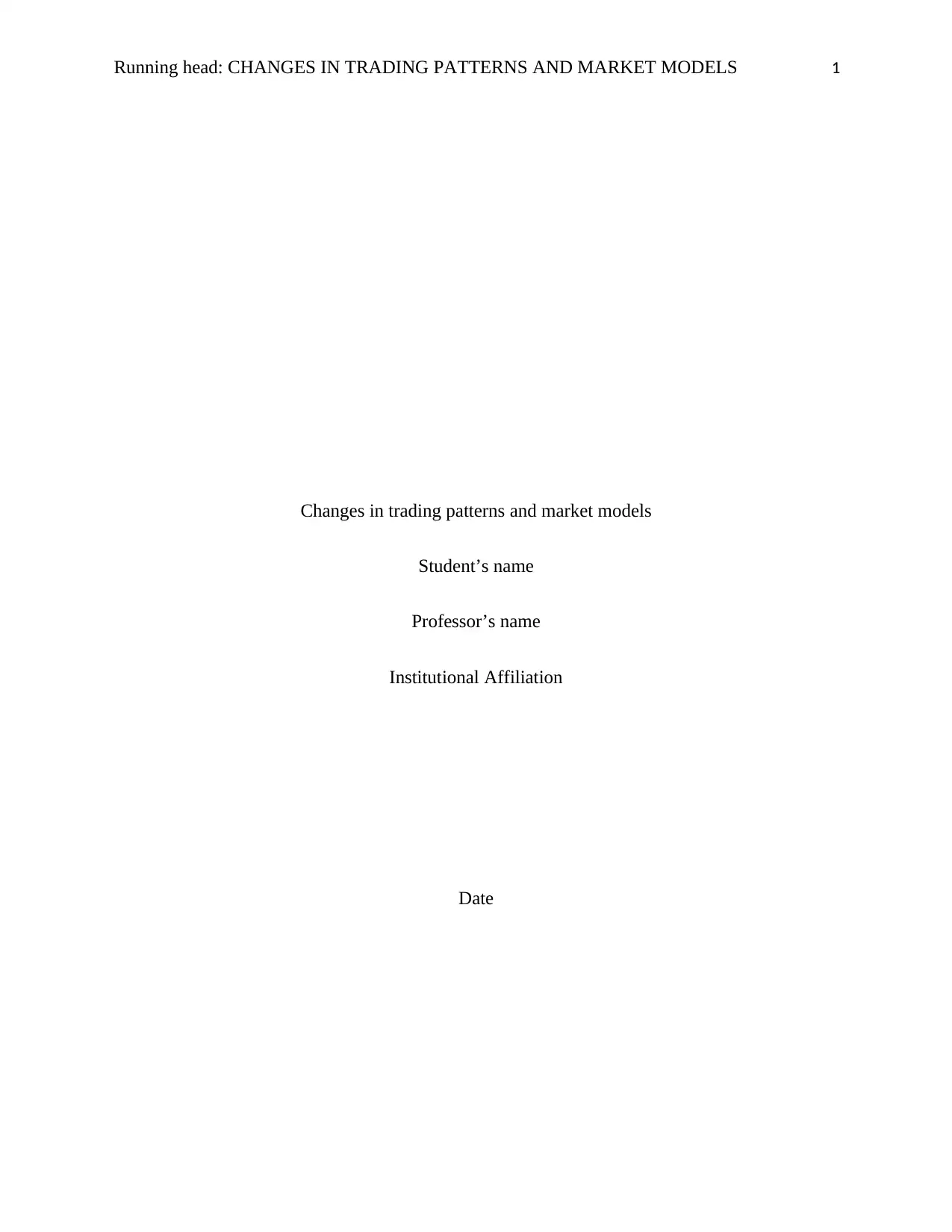
Running head: CHANGES IN TRADING PATTERNS AND MARKET MODELS 1
Changes in trading patterns and market models
Student’s name
Professor’s name
Institutional Affiliation
Date
Changes in trading patterns and market models
Student’s name
Professor’s name
Institutional Affiliation
Date
Paraphrase This Document
Need a fresh take? Get an instant paraphrase of this document with our AI Paraphraser
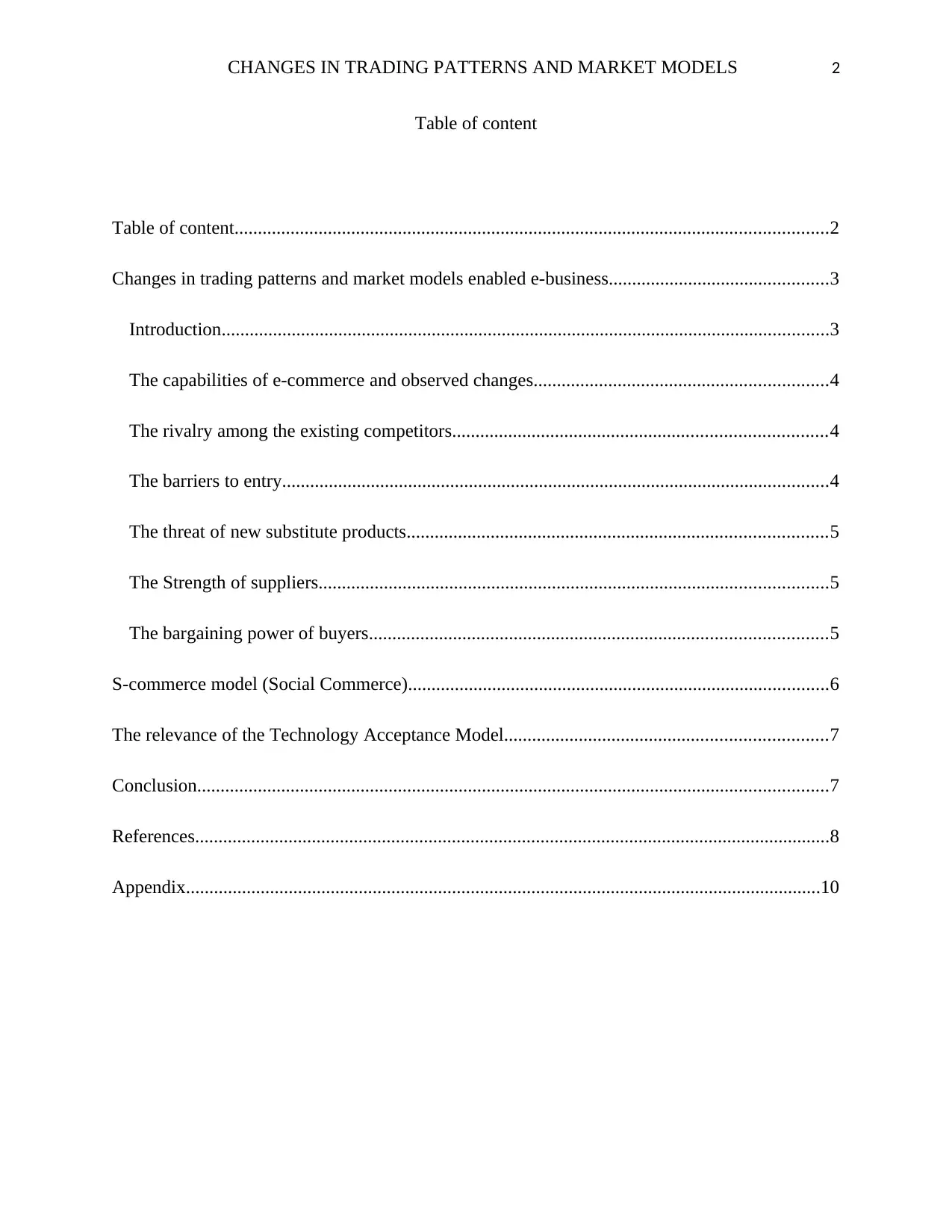
CHANGES IN TRADING PATTERNS AND MARKET MODELS 2
Table of content
Table of content...............................................................................................................................2
Changes in trading patterns and market models enabled e-business...............................................3
Introduction..................................................................................................................................3
The capabilities of e-commerce and observed changes...............................................................4
The rivalry among the existing competitors................................................................................4
The barriers to entry.....................................................................................................................4
The threat of new substitute products..........................................................................................5
The Strength of suppliers.............................................................................................................5
The bargaining power of buyers..................................................................................................5
S-commerce model (Social Commerce)..........................................................................................6
The relevance of the Technology Acceptance Model.....................................................................7
Conclusion.......................................................................................................................................7
References........................................................................................................................................8
Appendix........................................................................................................................................10
Table of content
Table of content...............................................................................................................................2
Changes in trading patterns and market models enabled e-business...............................................3
Introduction..................................................................................................................................3
The capabilities of e-commerce and observed changes...............................................................4
The rivalry among the existing competitors................................................................................4
The barriers to entry.....................................................................................................................4
The threat of new substitute products..........................................................................................5
The Strength of suppliers.............................................................................................................5
The bargaining power of buyers..................................................................................................5
S-commerce model (Social Commerce)..........................................................................................6
The relevance of the Technology Acceptance Model.....................................................................7
Conclusion.......................................................................................................................................7
References........................................................................................................................................8
Appendix........................................................................................................................................10
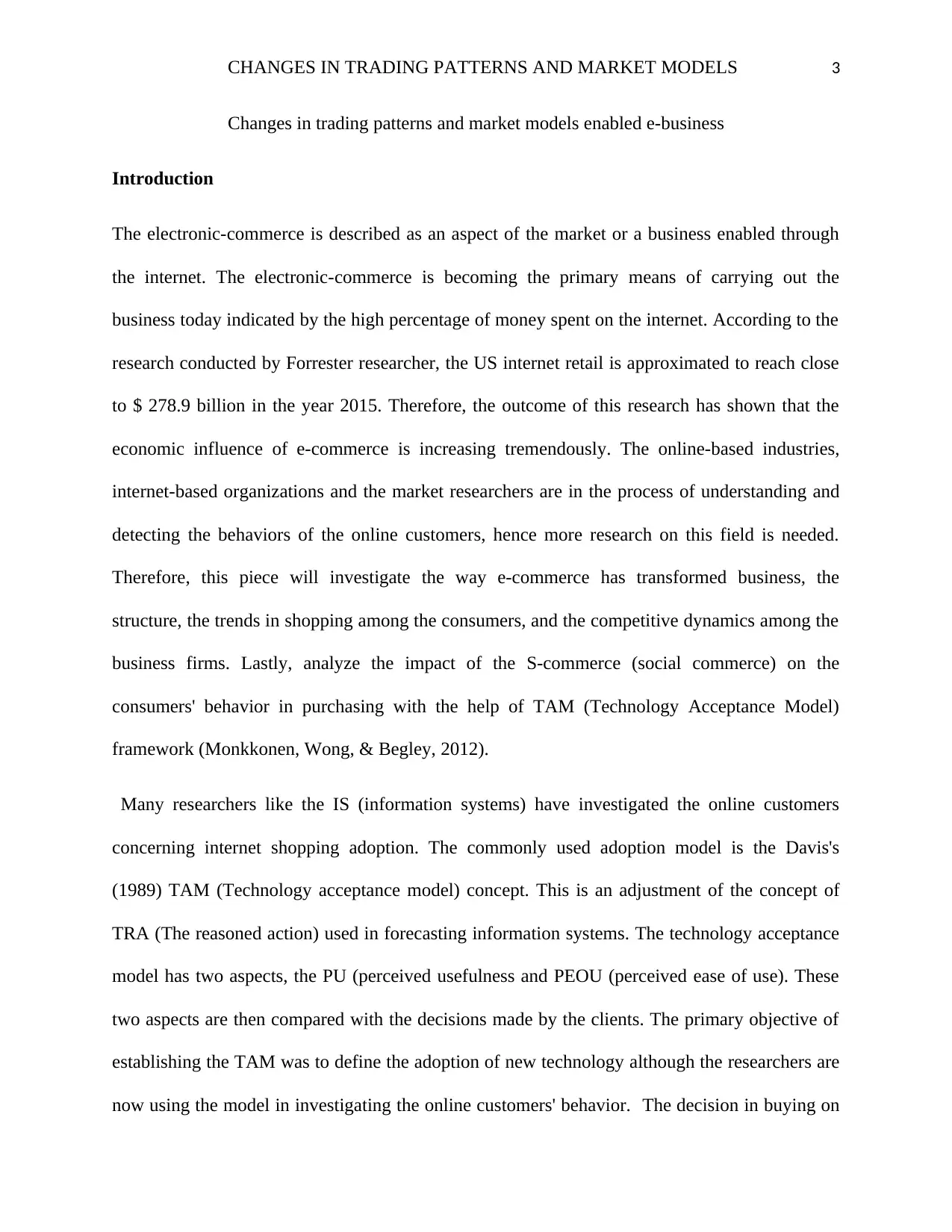
CHANGES IN TRADING PATTERNS AND MARKET MODELS 3
Changes in trading patterns and market models enabled e-business
Introduction
The electronic-commerce is described as an aspect of the market or a business enabled through
the internet. The electronic-commerce is becoming the primary means of carrying out the
business today indicated by the high percentage of money spent on the internet. According to the
research conducted by Forrester researcher, the US internet retail is approximated to reach close
to $ 278.9 billion in the year 2015. Therefore, the outcome of this research has shown that the
economic influence of e-commerce is increasing tremendously. The online-based industries,
internet-based organizations and the market researchers are in the process of understanding and
detecting the behaviors of the online customers, hence more research on this field is needed.
Therefore, this piece will investigate the way e-commerce has transformed business, the
structure, the trends in shopping among the consumers, and the competitive dynamics among the
business firms. Lastly, analyze the impact of the S-commerce (social commerce) on the
consumers' behavior in purchasing with the help of TAM (Technology Acceptance Model)
framework (Monkkonen, Wong, & Begley, 2012).
Many researchers like the IS (information systems) have investigated the online customers
concerning internet shopping adoption. The commonly used adoption model is the Davis's
(1989) TAM (Technology acceptance model) concept. This is an adjustment of the concept of
TRA (The reasoned action) used in forecasting information systems. The technology acceptance
model has two aspects, the PU (perceived usefulness and PEOU (perceived ease of use). These
two aspects are then compared with the decisions made by the clients. The primary objective of
establishing the TAM was to define the adoption of new technology although the researchers are
now using the model in investigating the online customers' behavior. The decision in buying on
Changes in trading patterns and market models enabled e-business
Introduction
The electronic-commerce is described as an aspect of the market or a business enabled through
the internet. The electronic-commerce is becoming the primary means of carrying out the
business today indicated by the high percentage of money spent on the internet. According to the
research conducted by Forrester researcher, the US internet retail is approximated to reach close
to $ 278.9 billion in the year 2015. Therefore, the outcome of this research has shown that the
economic influence of e-commerce is increasing tremendously. The online-based industries,
internet-based organizations and the market researchers are in the process of understanding and
detecting the behaviors of the online customers, hence more research on this field is needed.
Therefore, this piece will investigate the way e-commerce has transformed business, the
structure, the trends in shopping among the consumers, and the competitive dynamics among the
business firms. Lastly, analyze the impact of the S-commerce (social commerce) on the
consumers' behavior in purchasing with the help of TAM (Technology Acceptance Model)
framework (Monkkonen, Wong, & Begley, 2012).
Many researchers like the IS (information systems) have investigated the online customers
concerning internet shopping adoption. The commonly used adoption model is the Davis's
(1989) TAM (Technology acceptance model) concept. This is an adjustment of the concept of
TRA (The reasoned action) used in forecasting information systems. The technology acceptance
model has two aspects, the PU (perceived usefulness and PEOU (perceived ease of use). These
two aspects are then compared with the decisions made by the clients. The primary objective of
establishing the TAM was to define the adoption of new technology although the researchers are
now using the model in investigating the online customers' behavior. The decision in buying on
⊘ This is a preview!⊘
Do you want full access?
Subscribe today to unlock all pages.

Trusted by 1+ million students worldwide
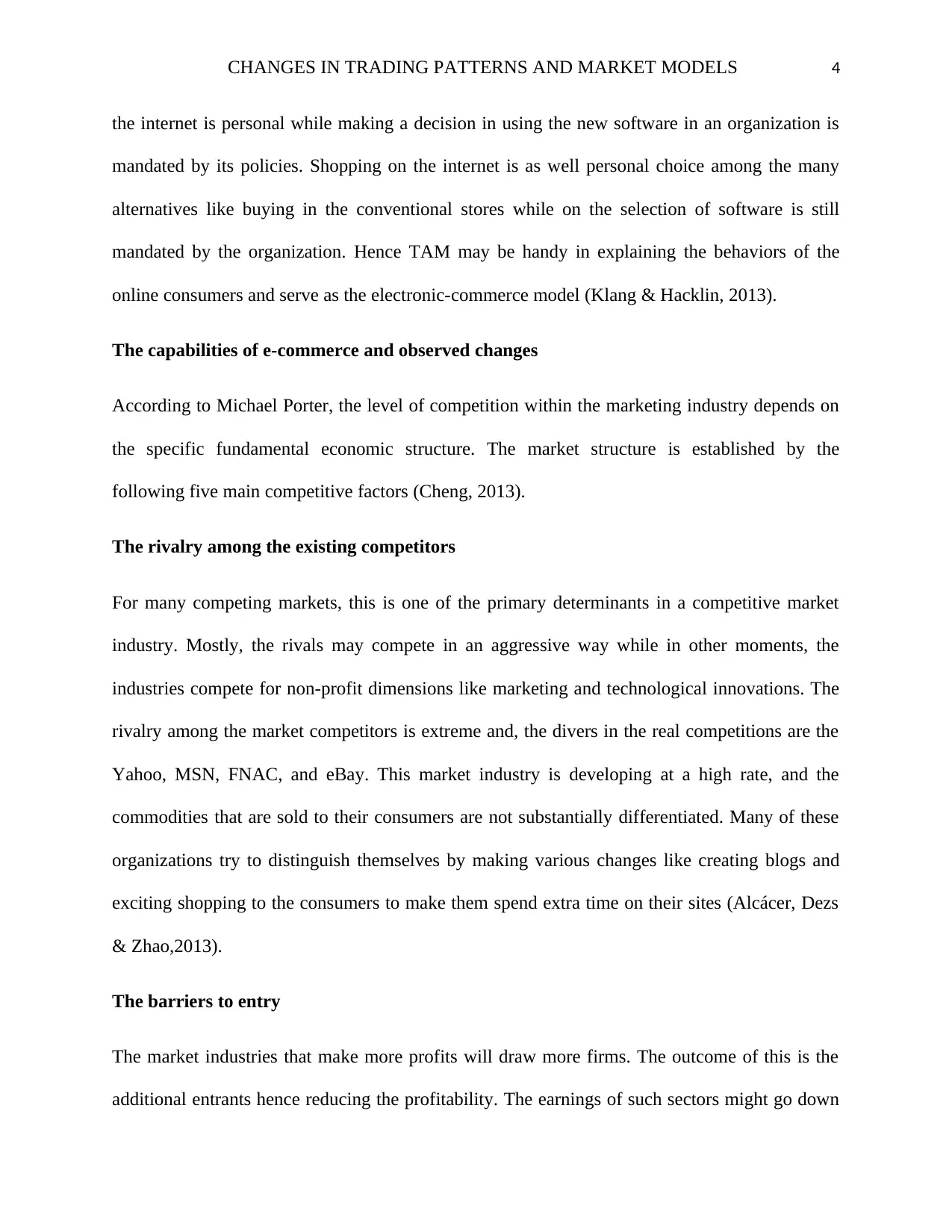
CHANGES IN TRADING PATTERNS AND MARKET MODELS 4
the internet is personal while making a decision in using the new software in an organization is
mandated by its policies. Shopping on the internet is as well personal choice among the many
alternatives like buying in the conventional stores while on the selection of software is still
mandated by the organization. Hence TAM may be handy in explaining the behaviors of the
online consumers and serve as the electronic-commerce model (Klang & Hacklin, 2013).
The capabilities of e-commerce and observed changes
According to Michael Porter, the level of competition within the marketing industry depends on
the specific fundamental economic structure. The market structure is established by the
following five main competitive factors (Cheng, 2013).
The rivalry among the existing competitors
For many competing markets, this is one of the primary determinants in a competitive market
industry. Mostly, the rivals may compete in an aggressive way while in other moments, the
industries compete for non-profit dimensions like marketing and technological innovations. The
rivalry among the market competitors is extreme and, the divers in the real competitions are the
Yahoo, MSN, FNAC, and eBay. This market industry is developing at a high rate, and the
commodities that are sold to their consumers are not substantially differentiated. Many of these
organizations try to distinguish themselves by making various changes like creating blogs and
exciting shopping to the consumers to make them spend extra time on their sites (Alcácer, Dezs
& Zhao,2013).
The barriers to entry
The market industries that make more profits will draw more firms. The outcome of this is the
additional entrants hence reducing the profitability. The earnings of such sectors might go down
the internet is personal while making a decision in using the new software in an organization is
mandated by its policies. Shopping on the internet is as well personal choice among the many
alternatives like buying in the conventional stores while on the selection of software is still
mandated by the organization. Hence TAM may be handy in explaining the behaviors of the
online consumers and serve as the electronic-commerce model (Klang & Hacklin, 2013).
The capabilities of e-commerce and observed changes
According to Michael Porter, the level of competition within the marketing industry depends on
the specific fundamental economic structure. The market structure is established by the
following five main competitive factors (Cheng, 2013).
The rivalry among the existing competitors
For many competing markets, this is one of the primary determinants in a competitive market
industry. Mostly, the rivals may compete in an aggressive way while in other moments, the
industries compete for non-profit dimensions like marketing and technological innovations. The
rivalry among the market competitors is extreme and, the divers in the real competitions are the
Yahoo, MSN, FNAC, and eBay. This market industry is developing at a high rate, and the
commodities that are sold to their consumers are not substantially differentiated. Many of these
organizations try to distinguish themselves by making various changes like creating blogs and
exciting shopping to the consumers to make them spend extra time on their sites (Alcácer, Dezs
& Zhao,2013).
The barriers to entry
The market industries that make more profits will draw more firms. The outcome of this is the
additional entrants hence reducing the profitability. The earnings of such sectors might go down
Paraphrase This Document
Need a fresh take? Get an instant paraphrase of this document with our AI Paraphraser
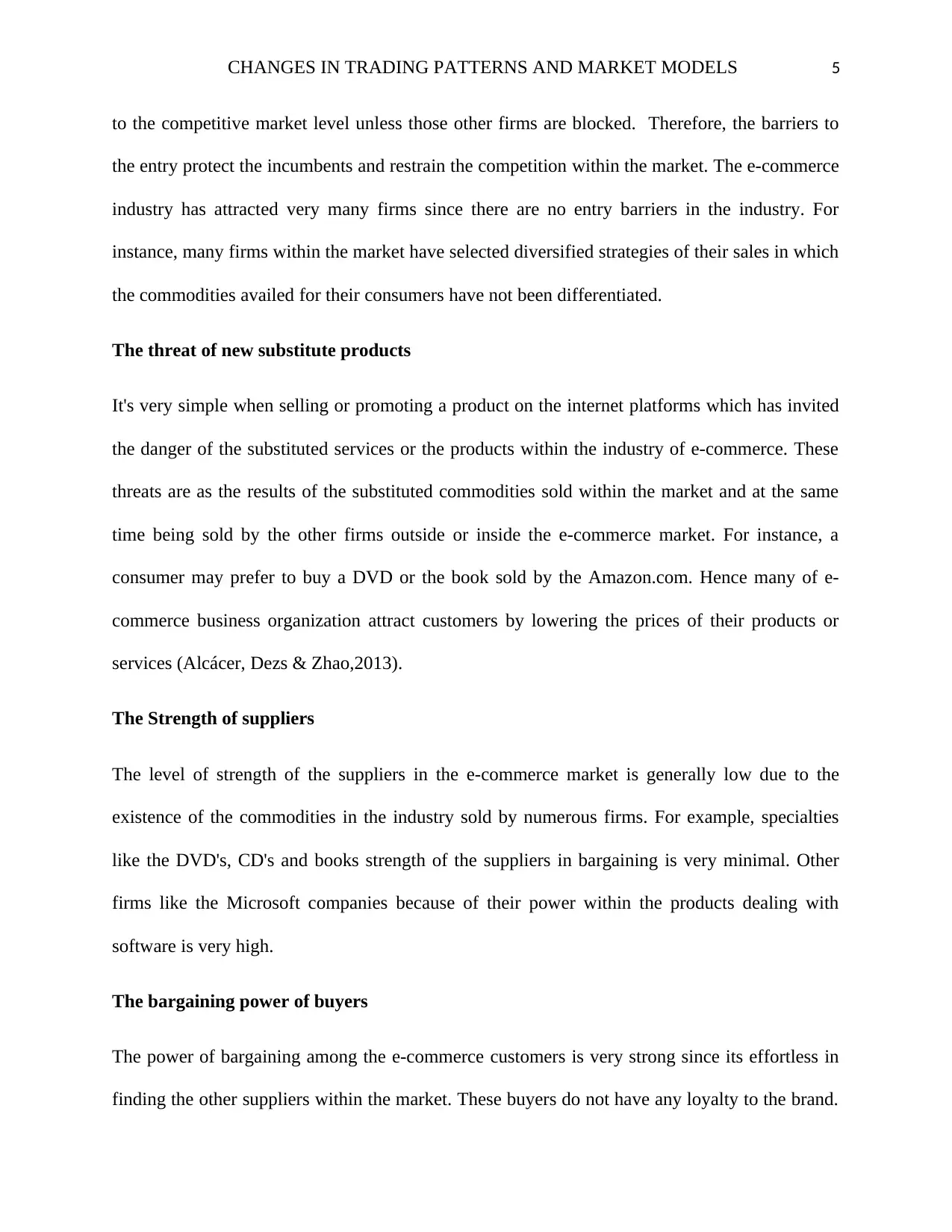
CHANGES IN TRADING PATTERNS AND MARKET MODELS 5
to the competitive market level unless those other firms are blocked. Therefore, the barriers to
the entry protect the incumbents and restrain the competition within the market. The e-commerce
industry has attracted very many firms since there are no entry barriers in the industry. For
instance, many firms within the market have selected diversified strategies of their sales in which
the commodities availed for their consumers have not been differentiated.
The threat of new substitute products
It's very simple when selling or promoting a product on the internet platforms which has invited
the danger of the substituted services or the products within the industry of e-commerce. These
threats are as the results of the substituted commodities sold within the market and at the same
time being sold by the other firms outside or inside the e-commerce market. For instance, a
consumer may prefer to buy a DVD or the book sold by the Amazon.com. Hence many of e-
commerce business organization attract customers by lowering the prices of their products or
services (Alcácer, Dezs & Zhao,2013).
The Strength of suppliers
The level of strength of the suppliers in the e-commerce market is generally low due to the
existence of the commodities in the industry sold by numerous firms. For example, specialties
like the DVD's, CD's and books strength of the suppliers in bargaining is very minimal. Other
firms like the Microsoft companies because of their power within the products dealing with
software is very high.
The bargaining power of buyers
The power of bargaining among the e-commerce customers is very strong since its effortless in
finding the other suppliers within the market. These buyers do not have any loyalty to the brand.
to the competitive market level unless those other firms are blocked. Therefore, the barriers to
the entry protect the incumbents and restrain the competition within the market. The e-commerce
industry has attracted very many firms since there are no entry barriers in the industry. For
instance, many firms within the market have selected diversified strategies of their sales in which
the commodities availed for their consumers have not been differentiated.
The threat of new substitute products
It's very simple when selling or promoting a product on the internet platforms which has invited
the danger of the substituted services or the products within the industry of e-commerce. These
threats are as the results of the substituted commodities sold within the market and at the same
time being sold by the other firms outside or inside the e-commerce market. For instance, a
consumer may prefer to buy a DVD or the book sold by the Amazon.com. Hence many of e-
commerce business organization attract customers by lowering the prices of their products or
services (Alcácer, Dezs & Zhao,2013).
The Strength of suppliers
The level of strength of the suppliers in the e-commerce market is generally low due to the
existence of the commodities in the industry sold by numerous firms. For example, specialties
like the DVD's, CD's and books strength of the suppliers in bargaining is very minimal. Other
firms like the Microsoft companies because of their power within the products dealing with
software is very high.
The bargaining power of buyers
The power of bargaining among the e-commerce customers is very strong since its effortless in
finding the other suppliers within the market. These buyers do not have any loyalty to the brand.
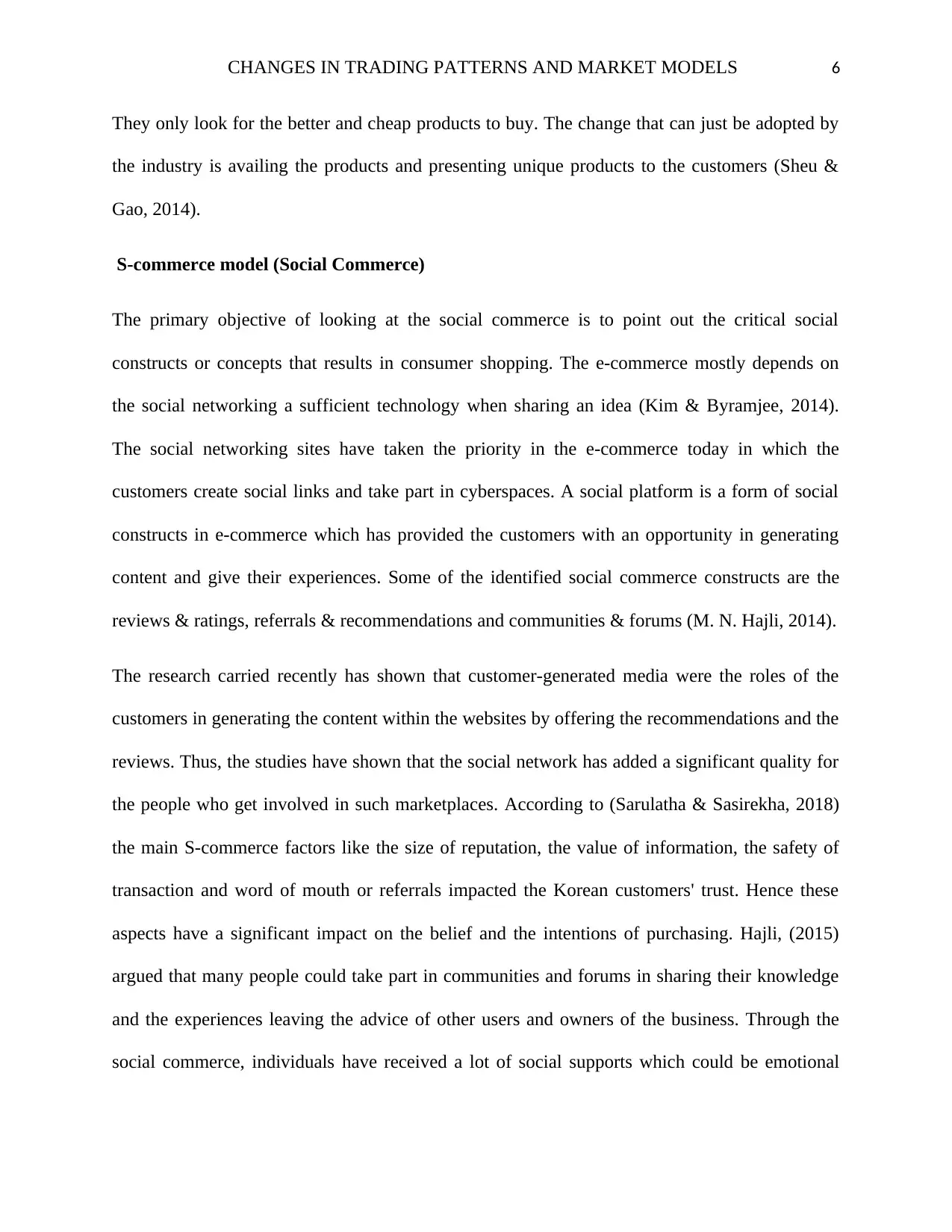
CHANGES IN TRADING PATTERNS AND MARKET MODELS 6
They only look for the better and cheap products to buy. The change that can just be adopted by
the industry is availing the products and presenting unique products to the customers (Sheu &
Gao, 2014).
S-commerce model (Social Commerce)
The primary objective of looking at the social commerce is to point out the critical social
constructs or concepts that results in consumer shopping. The e-commerce mostly depends on
the social networking a sufficient technology when sharing an idea (Kim & Byramjee, 2014).
The social networking sites have taken the priority in the e-commerce today in which the
customers create social links and take part in cyberspaces. A social platform is a form of social
constructs in e-commerce which has provided the customers with an opportunity in generating
content and give their experiences. Some of the identified social commerce constructs are the
reviews & ratings, referrals & recommendations and communities & forums (M. N. Hajli, 2014).
The research carried recently has shown that customer-generated media were the roles of the
customers in generating the content within the websites by offering the recommendations and the
reviews. Thus, the studies have shown that the social network has added a significant quality for
the people who get involved in such marketplaces. According to (Sarulatha & Sasirekha, 2018)
the main S-commerce factors like the size of reputation, the value of information, the safety of
transaction and word of mouth or referrals impacted the Korean customers' trust. Hence these
aspects have a significant impact on the belief and the intentions of purchasing. Hajli, (2015)
argued that many people could take part in communities and forums in sharing their knowledge
and the experiences leaving the advice of other users and owners of the business. Through the
social commerce, individuals have received a lot of social supports which could be emotional
They only look for the better and cheap products to buy. The change that can just be adopted by
the industry is availing the products and presenting unique products to the customers (Sheu &
Gao, 2014).
S-commerce model (Social Commerce)
The primary objective of looking at the social commerce is to point out the critical social
constructs or concepts that results in consumer shopping. The e-commerce mostly depends on
the social networking a sufficient technology when sharing an idea (Kim & Byramjee, 2014).
The social networking sites have taken the priority in the e-commerce today in which the
customers create social links and take part in cyberspaces. A social platform is a form of social
constructs in e-commerce which has provided the customers with an opportunity in generating
content and give their experiences. Some of the identified social commerce constructs are the
reviews & ratings, referrals & recommendations and communities & forums (M. N. Hajli, 2014).
The research carried recently has shown that customer-generated media were the roles of the
customers in generating the content within the websites by offering the recommendations and the
reviews. Thus, the studies have shown that the social network has added a significant quality for
the people who get involved in such marketplaces. According to (Sarulatha & Sasirekha, 2018)
the main S-commerce factors like the size of reputation, the value of information, the safety of
transaction and word of mouth or referrals impacted the Korean customers' trust. Hence these
aspects have a significant impact on the belief and the intentions of purchasing. Hajli, (2015)
argued that many people could take part in communities and forums in sharing their knowledge
and the experiences leaving the advice of other users and owners of the business. Through the
social commerce, individuals have received a lot of social supports which could be emotional
⊘ This is a preview!⊘
Do you want full access?
Subscribe today to unlock all pages.

Trusted by 1+ million students worldwide
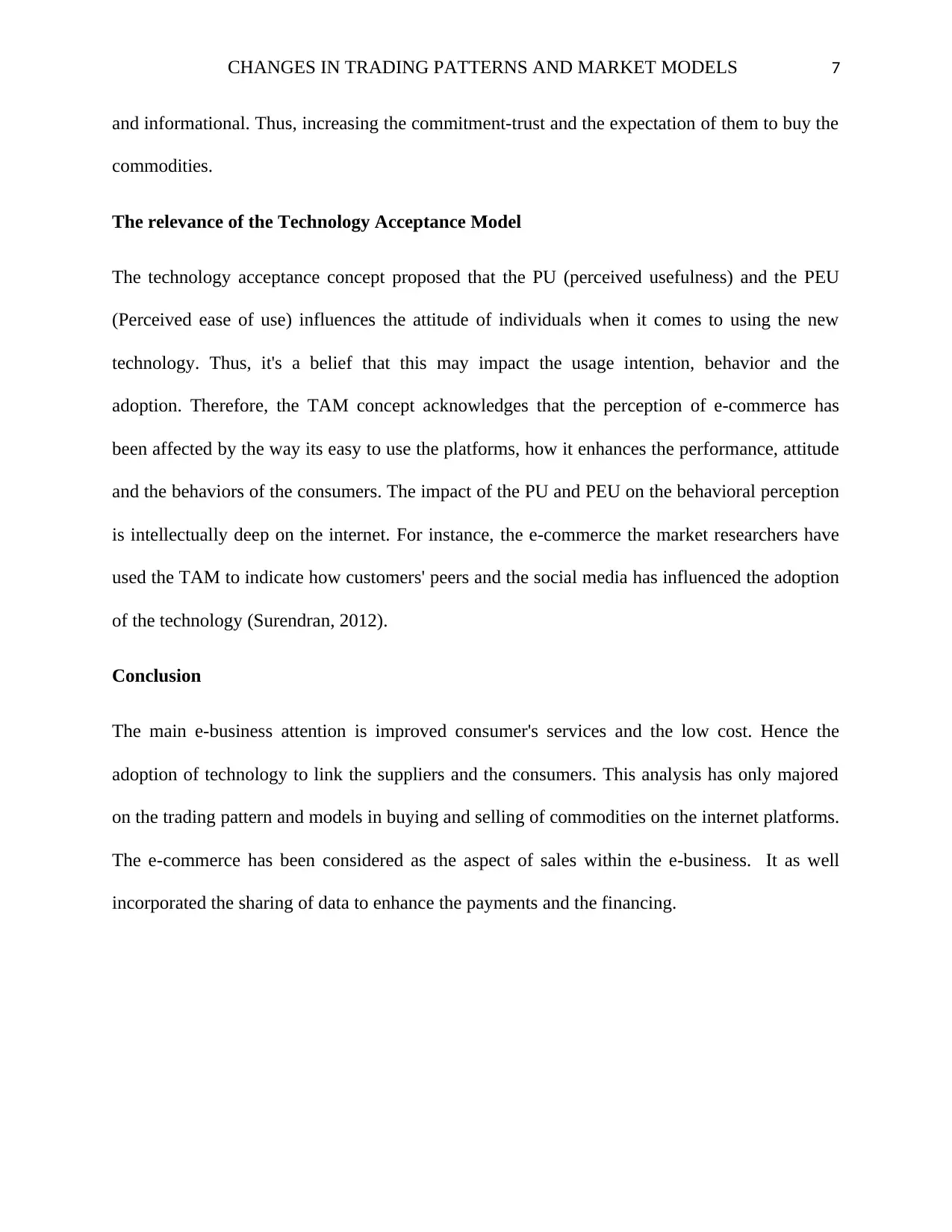
CHANGES IN TRADING PATTERNS AND MARKET MODELS 7
and informational. Thus, increasing the commitment-trust and the expectation of them to buy the
commodities.
The relevance of the Technology Acceptance Model
The technology acceptance concept proposed that the PU (perceived usefulness) and the PEU
(Perceived ease of use) influences the attitude of individuals when it comes to using the new
technology. Thus, it's a belief that this may impact the usage intention, behavior and the
adoption. Therefore, the TAM concept acknowledges that the perception of e-commerce has
been affected by the way its easy to use the platforms, how it enhances the performance, attitude
and the behaviors of the consumers. The impact of the PU and PEU on the behavioral perception
is intellectually deep on the internet. For instance, the e-commerce the market researchers have
used the TAM to indicate how customers' peers and the social media has influenced the adoption
of the technology (Surendran, 2012).
Conclusion
The main e-business attention is improved consumer's services and the low cost. Hence the
adoption of technology to link the suppliers and the consumers. This analysis has only majored
on the trading pattern and models in buying and selling of commodities on the internet platforms.
The e-commerce has been considered as the aspect of sales within the e-business. It as well
incorporated the sharing of data to enhance the payments and the financing.
and informational. Thus, increasing the commitment-trust and the expectation of them to buy the
commodities.
The relevance of the Technology Acceptance Model
The technology acceptance concept proposed that the PU (perceived usefulness) and the PEU
(Perceived ease of use) influences the attitude of individuals when it comes to using the new
technology. Thus, it's a belief that this may impact the usage intention, behavior and the
adoption. Therefore, the TAM concept acknowledges that the perception of e-commerce has
been affected by the way its easy to use the platforms, how it enhances the performance, attitude
and the behaviors of the consumers. The impact of the PU and PEU on the behavioral perception
is intellectually deep on the internet. For instance, the e-commerce the market researchers have
used the TAM to indicate how customers' peers and the social media has influenced the adoption
of the technology (Surendran, 2012).
Conclusion
The main e-business attention is improved consumer's services and the low cost. Hence the
adoption of technology to link the suppliers and the consumers. This analysis has only majored
on the trading pattern and models in buying and selling of commodities on the internet platforms.
The e-commerce has been considered as the aspect of sales within the e-business. It as well
incorporated the sharing of data to enhance the payments and the financing.
Paraphrase This Document
Need a fresh take? Get an instant paraphrase of this document with our AI Paraphraser
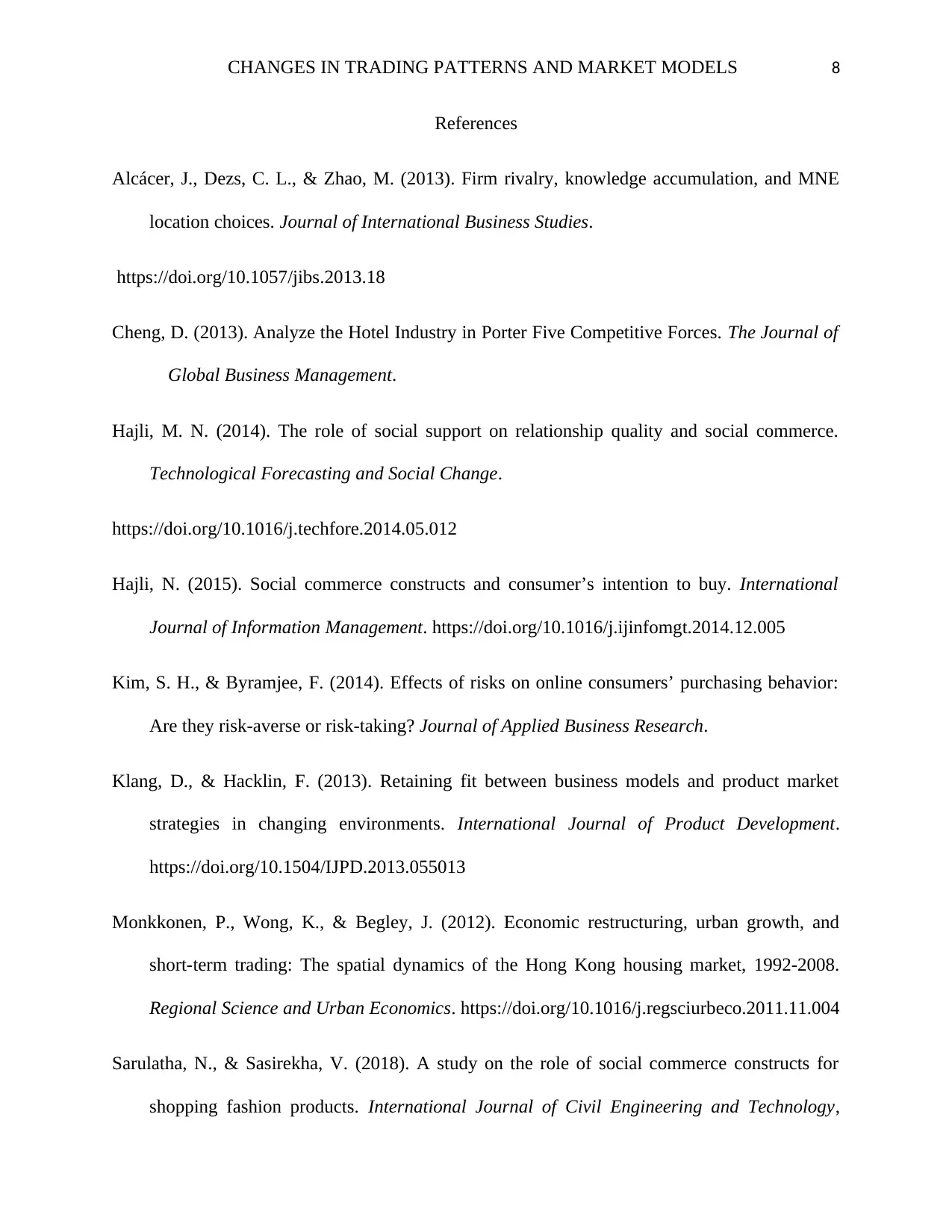
CHANGES IN TRADING PATTERNS AND MARKET MODELS 8
References
Alcácer, J., Dezs, C. L., & Zhao, M. (2013). Firm rivalry, knowledge accumulation, and MNE
location choices. Journal of International Business Studies.
https://doi.org/10.1057/jibs.2013.18
Cheng, D. (2013). Analyze the Hotel Industry in Porter Five Competitive Forces. The Journal of
Global Business Management.
Hajli, M. N. (2014). The role of social support on relationship quality and social commerce.
Technological Forecasting and Social Change.
https://doi.org/10.1016/j.techfore.2014.05.012
Hajli, N. (2015). Social commerce constructs and consumer’s intention to buy. International
Journal of Information Management. https://doi.org/10.1016/j.ijinfomgt.2014.12.005
Kim, S. H., & Byramjee, F. (2014). Effects of risks on online consumers’ purchasing behavior:
Are they risk-averse or risk-taking? Journal of Applied Business Research.
Klang, D., & Hacklin, F. (2013). Retaining fit between business models and product market
strategies in changing environments. International Journal of Product Development.
https://doi.org/10.1504/IJPD.2013.055013
Monkkonen, P., Wong, K., & Begley, J. (2012). Economic restructuring, urban growth, and
short-term trading: The spatial dynamics of the Hong Kong housing market, 1992-2008.
Regional Science and Urban Economics. https://doi.org/10.1016/j.regsciurbeco.2011.11.004
Sarulatha, N., & Sasirekha, V. (2018). A study on the role of social commerce constructs for
shopping fashion products. International Journal of Civil Engineering and Technology,
References
Alcácer, J., Dezs, C. L., & Zhao, M. (2013). Firm rivalry, knowledge accumulation, and MNE
location choices. Journal of International Business Studies.
https://doi.org/10.1057/jibs.2013.18
Cheng, D. (2013). Analyze the Hotel Industry in Porter Five Competitive Forces. The Journal of
Global Business Management.
Hajli, M. N. (2014). The role of social support on relationship quality and social commerce.
Technological Forecasting and Social Change.
https://doi.org/10.1016/j.techfore.2014.05.012
Hajli, N. (2015). Social commerce constructs and consumer’s intention to buy. International
Journal of Information Management. https://doi.org/10.1016/j.ijinfomgt.2014.12.005
Kim, S. H., & Byramjee, F. (2014). Effects of risks on online consumers’ purchasing behavior:
Are they risk-averse or risk-taking? Journal of Applied Business Research.
Klang, D., & Hacklin, F. (2013). Retaining fit between business models and product market
strategies in changing environments. International Journal of Product Development.
https://doi.org/10.1504/IJPD.2013.055013
Monkkonen, P., Wong, K., & Begley, J. (2012). Economic restructuring, urban growth, and
short-term trading: The spatial dynamics of the Hong Kong housing market, 1992-2008.
Regional Science and Urban Economics. https://doi.org/10.1016/j.regsciurbeco.2011.11.004
Sarulatha, N., & Sasirekha, V. (2018). A study on the role of social commerce constructs for
shopping fashion products. International Journal of Civil Engineering and Technology,
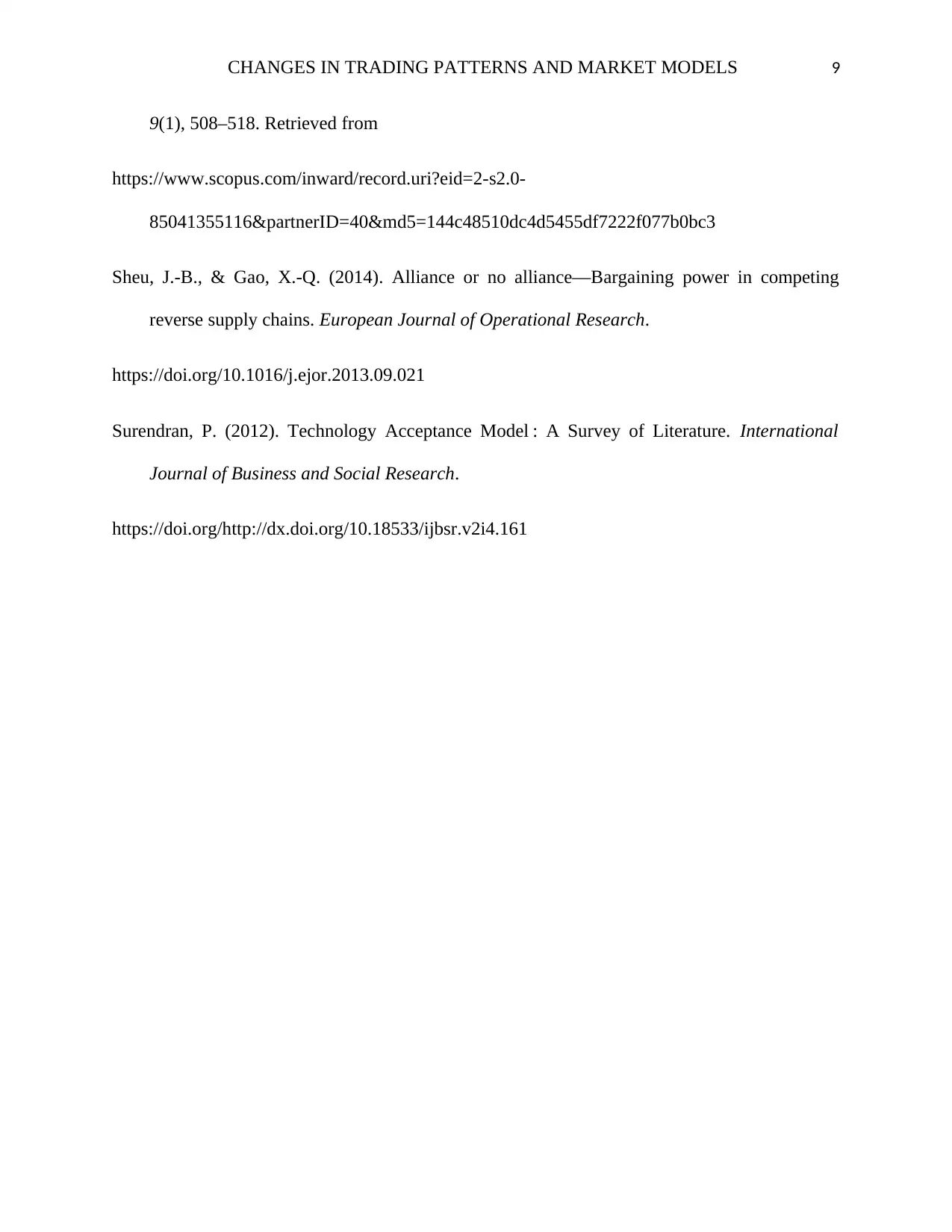
CHANGES IN TRADING PATTERNS AND MARKET MODELS 9
9(1), 508–518. Retrieved from
https://www.scopus.com/inward/record.uri?eid=2-s2.0-
85041355116&partnerID=40&md5=144c48510dc4d5455df7222f077b0bc3
Sheu, J.-B., & Gao, X.-Q. (2014). Alliance or no alliance—Bargaining power in competing
reverse supply chains. European Journal of Operational Research.
https://doi.org/10.1016/j.ejor.2013.09.021
Surendran, P. (2012). Technology Acceptance Model : A Survey of Literature. International
Journal of Business and Social Research.
https://doi.org/http://dx.doi.org/10.18533/ijbsr.v2i4.161
9(1), 508–518. Retrieved from
https://www.scopus.com/inward/record.uri?eid=2-s2.0-
85041355116&partnerID=40&md5=144c48510dc4d5455df7222f077b0bc3
Sheu, J.-B., & Gao, X.-Q. (2014). Alliance or no alliance—Bargaining power in competing
reverse supply chains. European Journal of Operational Research.
https://doi.org/10.1016/j.ejor.2013.09.021
Surendran, P. (2012). Technology Acceptance Model : A Survey of Literature. International
Journal of Business and Social Research.
https://doi.org/http://dx.doi.org/10.18533/ijbsr.v2i4.161
⊘ This is a preview!⊘
Do you want full access?
Subscribe today to unlock all pages.

Trusted by 1+ million students worldwide
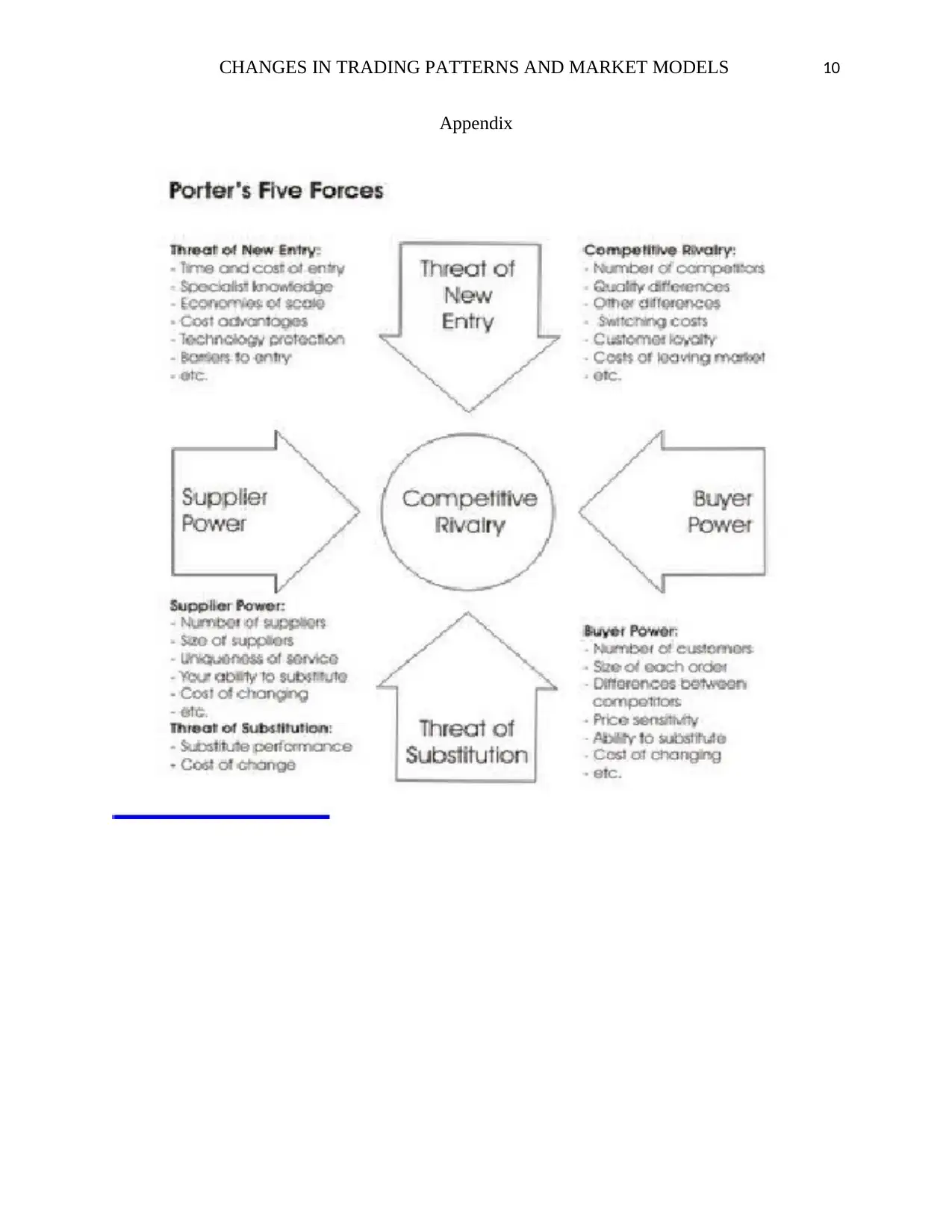
CHANGES IN TRADING PATTERNS AND MARKET MODELS 10
Appendix
Appendix
1 out of 10
Related Documents
Your All-in-One AI-Powered Toolkit for Academic Success.
+13062052269
info@desklib.com
Available 24*7 on WhatsApp / Email
![[object Object]](/_next/static/media/star-bottom.7253800d.svg)
Unlock your academic potential
Copyright © 2020–2025 A2Z Services. All Rights Reserved. Developed and managed by ZUCOL.





